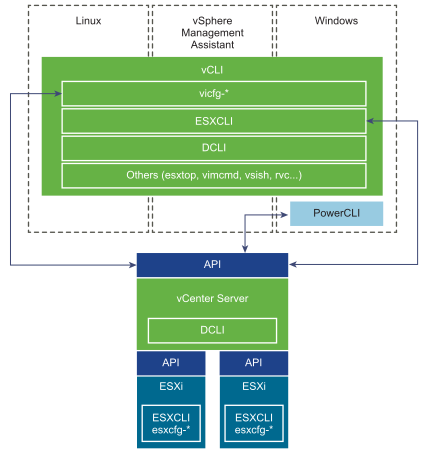vSphere includes
commands for managing different aspects of your environment.
The following CLIs are
available for managing hosts, either directly or through the
vCenter Server
system that manages the host. You can also manage vCenter services by using
DCLI.
vSphere CLIs for
Host and vCenter Services Management

|
|
|
|---|
|
Manage many aspects of an
ESXi host. You
can run ESXCLI commands remotely or in the
ESXi Shell.
■
|
vCLI package -
Install the vCLI package on the server of your choice, or deploy a vSphere
Management Assistant (vMA) virtual machine and target the
ESXi system
that you want to manipulate. You can run ESXCLI commands against a
vCenter Server
system and target the host indirectly. Running against
vCenter Server
systems by using the
-vihost parameter is required if the host is in
lockdown mode.
|
■
|
ESXi Shell -
Run ESXCLI commands in the local
ESXi Shell to
manage that host.
|
You can also run ESXCLI
commands from the VMware PowerCLI prompt by using the
Get-EsxCli cmdlet.
|
|
vicfg- and other vCLI commands
|
Users can manage hosts
remotely. Install the vCLI package on a Windows or Linux system or deploy a vMA
virtual machine, and target the
ESXi system
that you want to manipulate.
vicfg- commands are
included in this release but are deprecated. Migrate to ESXCLI where possible.
You can run the commands
against
ESXi systems or
against a
vCenter Server
system. If you target a
vCenter Server
system, use the
--vihost option to specify the target
ESXi system.
Note
If the
ESXi system is
in strict lockdown mode, you must run commands against the
vCenter Server
system that manages your
ESXi system.
|
Installing vCLI
vSphere Command-Line Concepts and
Examples
vSphere Command-Line Interface
Reference
|
|
Available in the
ESXi Shell.
esxcfg- commands are
included in this release but are deprecated. Migrate to ESXCLI where possible.
|
Command-Line Management of vSphere 5
and vSphere 6 for Service Console Users
|
|
Manage VMware SDDC
services.
DCLI is a CLI client to
the
vSphere
Automation SDK interface for managing VMware SDDC services. A
DCLI command talks to a
vSphere
Automation API endpoint to locate relevant information, and then
runs the command and displays the result to the user.
You can run DCLI commands
as follows.
■
|
vCenter Server
Appliance - Run DCLI commands from the
vCenter Server
Appliance shell. See
Running DCLI Commands on the vCenter Server Appliance.
|
■
|
vCenter Server Windows command prompt - Install
vCenter Server
on a supported Windows system and run DCLI commands from the command prompt.
|
■
|
vCLI package
■
|
Open a command
prompt on a Linux or Windows system on which you installed vCLI. Enter commands
into that command prompt, specifying connection options. See
Running DCLI Commands.
|
■
|
Access the vMA
Linux console. DCLI does not support the vi-fastpass connections.
|
|
■
|
Prepare scripts that
include DCLI commands and run the scripts as vCLI scripts from the
vCenter Server
Windows command prompt or from the
vCenter Server
Appliance shell.
|
|
Running DCLI Commands
See the
vSphere Automation
SDK documentation for information about supported services and how they
interact.
|
|
VMware PowerCLI
provides a Windows PowerShell interface to the vSphere API.
PowerCLI
includes PowerShell cmdlets for administering vSphere components.
PowerCLI
includes more than 500 cmdlets, a set of sample scripts, and a function library
for management and automation. The vSphere Image Builder PowerCLI and vSphere
Auto Deploy PowerCLI modules are included when you install
PowerCLI.
|
VMware PowerCLI documentation
|
|
Set of commands for use
with VMware Technical Support.
localcli commands are
equivalent to ESXCLI commands, but bypass the host daemon
(hostd) . The
localcli commands are
only for situations when
hostd is unavailable and cannot be restarted.
After you run a
localcli command, you
must restart
hostd. Run ESXCLI commands after the restart.
Note
If
you use a
localcli command, an
inconsistent system state and potential failure might result.
|
|
|
Enables you to monitor the
traffic that flows through the physical network adapters, the VMkernel
adapters, and the virtual machine adapters, and to analyze the packet
information by using conventional network analysis tools such as Wireshark.
|
vSphere Networking
documentation
|
|
Commands for managing the
vCenter Single Sign-On and certificate infrastructure.
|
vSphere Security
documentation
|
|
Enables you to configure
and troubleshoot the
vCenter Server
Appliance and to monitor the processes and services running in
the appliance.
|
vCenter Server Appliance
Configuration documentation
|
